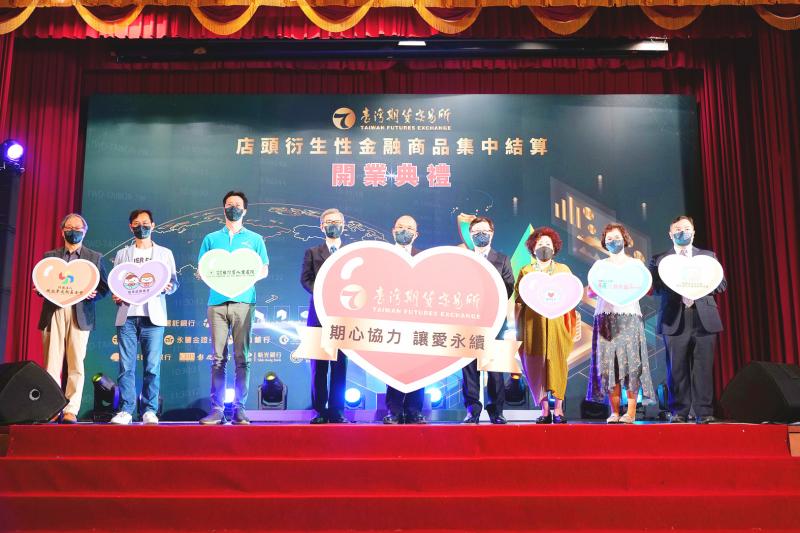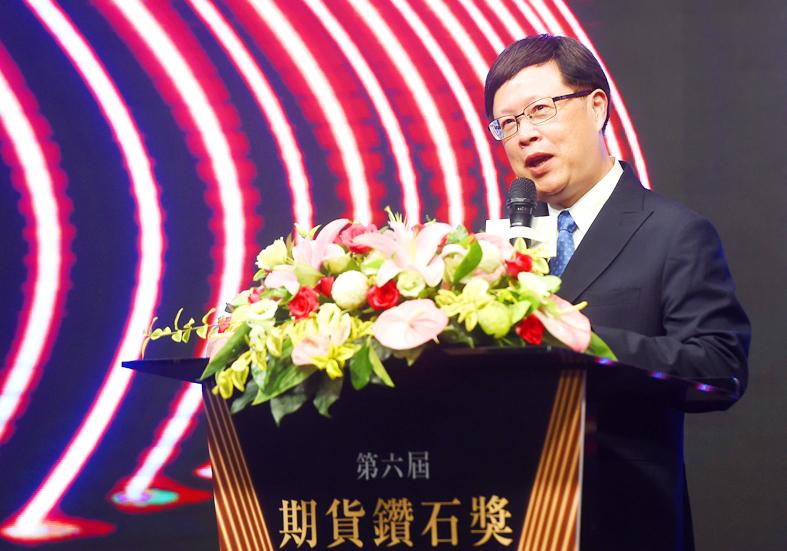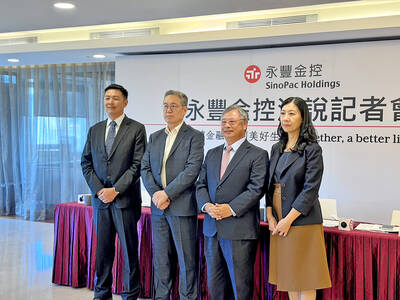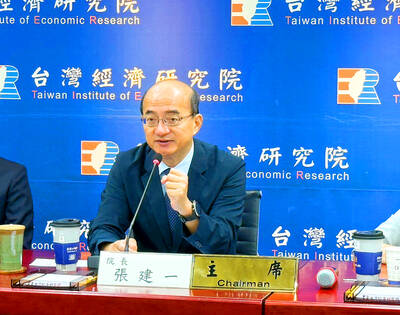Eleven domestic financial institutions have registered as members of a new over-the-counter (OTC) derivatives clearing business that the Taiwan Futures Exchange (TAIFEX) launched on Monday last week to bolster the resilience of the financial system and align with international supervision trends, the exchange said.
The 11 financial institutions are CTBC Bank (中信銀行), Yuanta Commercial Bank (元大銀行), Taipei Fubon Commercial Bank (台北富邦銀行), Bank SinoPac (永豐銀行), SinoPac Securities Co (永豐金證券), E.Sun Commercial Bank (玉山銀行), Taiwan Cooperative Bank (合庫銀行), Cathay United Bank (國泰世華銀行), Chang Hwa Commercial Bank (彰化銀行), Shin Kong Commercial Bank (新光銀行) and Bank of Taiwan (臺灣銀行), the exchange said.
Over-the-counter transactions are deals that take place outside the exchange. Usually, the transactions are negotiated between financial institutions, or conducted by brokers as an intermediary between buyers and sellers. Brokers usually ask potential buyers or sellers their acceptable prices and trading conditions by telephone or the Internet and seek to facilitate the deals, with buyers and sellers bearing the credit and default risks themselves.

Photo courtesy of Taiwan Futures Exchange
However, OTC derivatives transactions are complex and provide high financial leverage. For buyers and sellers, when one party defaults, it might trigger a domino effect and affect the stability of the financial market, the exchange said, citing the 2008 global financial crisis as an example that was caused by investments in complex derivatives by international financial institutions and eventually created systemic risks for global financial markets.
By establishing central clearing mechanisms for OTC derivatives, the risk of trading defaults can be transferred to the TAIFEX, and the original creditor-debtor relationship between buyers and sellers would become the relationship between the exchange and the buyers or sellers, it said.
In so doing, traders no longer need to face various counterparties with different risks, but only need to face the TAIFEX, which can simplify risk management operations and reduce costs.

Photo: Chien Jung-feng, Taipei Times
Moreover, the risks of each participant’s long and short positions in multiple transactions would offset each other, leaving only a single net position with the TAIFEX, which can reduce the total exposure of credit risks, it added.
The TAIFEX said it evaluates the value of each contract based on the market price every day, and its central clearing mechanism can handle profit-and-loss payments and implement risk management.
As a result, the risk status of each participant can be grasped in real time and alerted in advance, it said.
Even if a party defaults, the exchange’s financial defense pool can absorb the shock, and prevent the risk from continuing to expand and trigger a financial crisis, it added.
According to the regulations of the Financial Supervisory Commission, only 2 percent of the risk weight is required for financial institutions when calculating the accrued capital for the counterparty credit risk after conducting TAIFEX clearing.
Therefore, it can effectively reduce financial institutions’ capital accrual while improving their efficiency of fund utilization, the exchange said.
Moreover, in the past, domestic financial institutions usually conducted central clearing through foreign settlement institutions such as the London Clearing House, and the fees were very high, it said.
The exchange’s OTC central clearing mechanism hence allows transactions to be handled domestically, which provides financial institutions more convenience along with lower operating costs, it added.
The clearing mechanism is the central nervous system of a nation’s financial market. To ensure control over the core technologies behind Taiwan’s financial market, the TAIFEX independently developed the clearing system by integrating 15 modules rather than purchasing one, it said.
Only by ensuring smooth clearing and settlement can Taiwan build confidence in trading and allow the market to flourish, the TAIFEX said, adding that the OTC central clearing mechanism would ensure the safety of people’s transactions and reduce the financial industry’s operating costs, as well as create a favorable trading and hedging environment in the nation.
Overall, the establishment of the new OTC central clearing mechanism is expected to provide more convenience for market participants, boost the resilience of the financial system, attract foreign capital to the local market and enhance Taiwan’s international visibility, the exchange said.
The TAIFEX has been seeking accreditation as a qualified central counterparty in the US, the EU, the UK and Canada to attract foreign capital and enhance the domestic market’s international competitiveness, it said.
In addition to the launch of the new OTC derivatives clearing business on Monday, TAIFEX also organized charity activities on the same day to fulfill its corporate social responsibility. Witnessed by Premier Su Tseng-chang (蘇貞昌) and Financial Supervisory Commission Chairman Thomas Huang (黃天牧), TAIFEX chairman Wu Tzu-hsin (吳自心) made donations totaling NT$3 million (US$100,207) on behalf of the exchange to six organizations in an effort to help disadvantaged groups such as the physically and mentally handicapped, older people with dementia, single-parent families and people with rare diseases.
The TAIFEX also hopes to shrink the gap between urban and rural areas, extend its attention to art and cultural organizations in remote areas, and encourage more enterprises to jointly build a more inclusive society and achieve sustainable development.

SETBACK: Apple’s India iPhone push has been disrupted after Foxconn recalled hundreds of Chinese engineers, amid Beijing’s attempts to curb tech transfers Apple Inc assembly partner Hon Hai Precision Industry Co (鴻海精密), also known internationally as Foxconn Technology Group (富士康科技集團), has recalled about 300 Chinese engineers from a factory in India, the latest setback for the iPhone maker’s push to rapidly expand in the country. The extraction of Chinese workers from the factory of Yuzhan Technology (India) Private Ltd, a Hon Hai component unit, in southern Tamil Nadu state, is the second such move in a few months. The company has started flying in Taiwanese engineers to replace staff leaving, people familiar with the matter said, asking not to be named, as the

The prices of gasoline and diesel at domestic fuel stations are to rise NT$0.1 and NT$0.4 per liter this week respectively, after international crude oil prices rose last week, CPC Corp, Taiwan (台灣中油) and Formosa Petrochemical Corp (台塑石化) announced yesterday. Effective today, gasoline prices at CPC and Formosa stations are to rise to NT$27.3, NT$28.8 and NT$30.8 per liter for 92, 95 and 98-octane unleaded gasoline respectively, the companies said in separate statements. The price of premium diesel is to rise to NT$26.2 per liter at CPC stations and NT$26 at Formosa pumps, they said. The announcements came after international crude oil prices

SinoPac Financial Holdings Co (永豐金控) is weighing whether to add a life insurance business to its portfolio, but would tread cautiously after completing three acquisitions in quick succession, president Stanley Chu (朱士廷) said yesterday. “We are carefully considering whether life insurance should play a role in SinoPac’s business map,” Chu told reporters ahead of an earnings conference. “Our priority is to ensure the success of the deals we have already made, even though we are tracking some possible targets.” Local media have reported that Mercuries Life Insurance Co (三商美邦人壽), which is seeking buyers amid financial strains, has invited three financial

CAUTION: Right now, artificial intelligence runs on faith, not productivity and eventually, the risk of a bubble will emerge,’ TIER economist Gordon Sun said Taiwanese manufacturers turned more optimistic last month, ending a five-month streak of declining sentiment as concerns over US tariffs, currency volatility and China’s overcapacity began to ease, the Taiwan Institute of Economic Research (TIER) said yesterday. The manufacturing business confidence index rose 1.17 points from June to 86.8, its first rebound since February. TIER economist Gordon Sun (孫明德) attributed the uptick to fading trade uncertainties, a steadier New Taiwan dollar and reduced competitive pressure from Chinese producers. Taiwan’s semiconductor industry is unlikely to face significant damage from Washington’s ongoing probe into semiconductors, given the US’ reliance on Taiwanese chips to power artificial